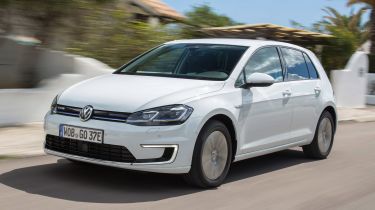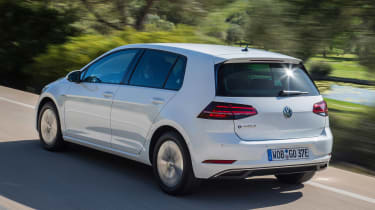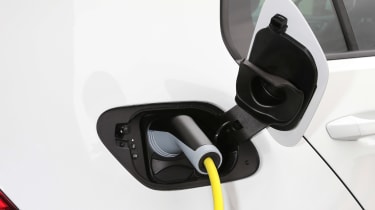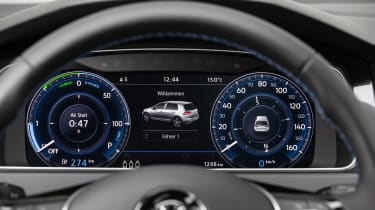New Volkswagen e-Golf 2017 review
All-electric Volkswagen Golf receives new tech, more power and big range boost for 2017 – can it compete with the best EVs as a result?
It’s still expensive, but for those with the means and the ability to charge at home, the Volkswagen e-Golf is a very capable electric car. The range and power boosts bring the electric Golf into line with the best in this class, while its effortless drive, solidly built interior and practical cabin should pique the interest of even the hardiest EV sceptics. The fact that it looks just like a regular Golf will be a boon for those put off by the quirky BMW i3, too.
The rollout of the updated Volkswagen Golf range continues at a pace with this: the all-electric e-Golf. We’ve now driven everything from the new 1.5 TSI petrol to the facelifted 306bhp Golf R, but this is our first chance to get to grips with the battery-powered family hatch. It gets the same tech updates as other Golfs, but more power and greater range than before.
Of the near-half a million Golfs sold in Europe last year, only a tiny fraction featured an electric powertrain. Most of those were the plug-in hybrid GTE, too, so the e-Golf – first launched three years ago – still has plenty of ground to cover to take battery power to the mainstream market. Sales projections are much more positive for 2017 and beyond, however.
The biggest change will be the extension in predicted range. VW has managed to fit a more energy dense lithium-ion battery, allowing greater capacity without increasing the physical size of the pack. As a result, the claimed range has risen from 119 miles to 186 miles, while you can now charge it to 80 per cent from a fast charging point in just 45 minutes. It still takes four hours to charge fully on a home charger, or 13 hours from a domestic three-pin plug socket, and we’d expect around 130 miles to be achievable in the real world.
More reviews
Car group tests
- Volkswagen ID.3 vs Volkswagen e-Golf
- Nissan Leaf vs BMW i3 vs VW e-Golf vs Renault ZOE
- Volkswagen e-Golf vs BMW i3
In-depth reviews
Long-term tests
Road tests
• Best electric cars on sale right now
While it’s not a remarkable increase, the range improvements put the e-Golf on a par with the Hyundai Ioniq and ahead of the Nissan Leaf. It also opens up EV ownership to those with slightly longer commutes – though it’ll remain only a sensible second car for most. The considerable (if unconfirmed) price is an issue, it’s expected to be no better or worse than the Ioniq, and the Golf still qualifies for the maximum £4,500 government grant for plug-in vehicles. It’s free to tax, too.
Pleasingly, VW has also boosted the electric motor’s output from 113bhp to 134bhp, while torque is up 20Nm to 289Nm. It might not sound like much, but it’s shaved a noticeable eight-tenths off the e-Golf’s 0-62mph time. It feels more sprightly than most mainstream EVs and a touch less breathless at motorway speeds than before, although it’s still a way off delivering the punch of the BMW i3’s motor.
Regardless, it’s entertainingly swift off the line, as smooth and as quiet as the best, and just about capable of holding its own on the motorway. As before, you can dial in extra engine braking by shifting into ‘B mode’, but there’s also a new ‘Eco Tips’ function in the Active Info Display which uses sat-nav data to inform you when is best to accelerate or lift off the throttle. VW has made no changes to the suspension, so the e-Golf retains its tidy handling and comfortable (if slightly fidgety) ride around town.
It should also help that VW hasn’t gone down the route of making the e-Golf look strikingly different from a conventional petrol or diesel model. The front and rear are barely changed for 2017, with the new LED light designs and Audi-style scrolling indicators the only noticeable tweaks.
Other than that it’s only the badging, the aero-optimised wheels and the thin blue strip that runs the width of the front-end that distinguish this from a normal hatch. Compared to the polarizing designs of cars like the i3, the e-Golf doesn’t shout about its eco credentials, and it’s all the better for it.
There’s more to get excited about inside. Like many top-spec Golfs you’ll find new tech in the form of VW’s 12.3-inch Active Info Display, which replaces lesser cars’ analogue dials. This is particularly useful in the EV, allowing you to prioritise things like remaining range, as well as accessing real-time info on the required length of your next charging stop. Elsewhere, all e-Golfs get the glossy new 9.2-inch Discover Pro infotainment system as standard, which is feature-packed and largely slick to operate - save, that is, for the rather useless hand-swipe gesture control.
Aside from that, it’s the same sober but impressively solid Golf interior that we’ve grown to appreciate over the years. From the inside, the only clues that you’re driving an EV are the subtle badges and the blue stitching. Sticking the electric motor where the engine usually is means that there’s no dent to the VW’s ample rear passenger space, either, although the 341 litre boot is 39 litres down on the standard car due to the batteries under the floor.






